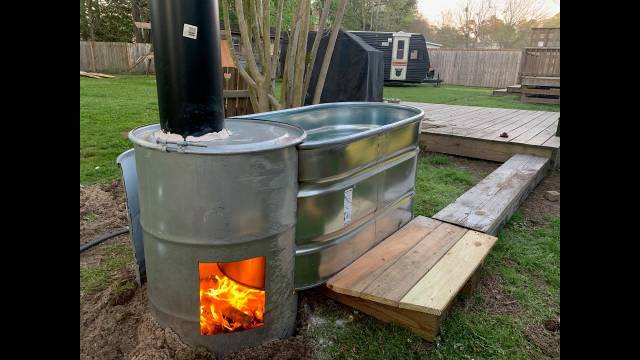In the middle of freezing winter, you’re probably wishing you had a hot tub to warm up in. If you’re on a budget or looking to utilize your DIY skills, it’s possible to build one on your own. In theory, a hot tub is simple to make: it needs to hold hot water, people, and heat up.
A DIY hot tub evokes a simple and natural aesthetic, one that most prefer today. Many are going for a wood-fired hot tub, due to its convenience and easy build. Before you build your very own wood-fired tub, there are a few things to plan and consider including filtration systems and materials.
If you’re building one yourself, you’ll need to pick what to make the tub out of. Once that’s sorted, you’ll need to choose from two main types of wood-burning heating systems. While the process might look daunting, the end result may just be worth it. Who wouldn’t want nice, long soaks without having to use any electricity at all?
Keep reading on to know more about what it takes to build a wood-burning hot tub heater.
Picking Your Tub Material
Interestingly, DIY wood-fired hot tubs have not gained that much traction. Because of this, there aren’t many trends to refer to when choosing tub materials. When it comes to choosing what material you want, choose one based on how you want it to look. Certain materials also require a higher skill with tools to work with them. So based on this, you’ll also want to choose material that you can handle.
For those that have built their own tubs, many of them go for large stock tanks. These are the kind that are used to provide water for cattle. You can choose from either rubberized plastic or galvanized steel, but the size and shape can vary. A thin and narrow tank is preferable for solo soaking, as it’s easier to heat and uses less water. On the other hand, a round tank is better for multiple people using the tub at the same time.
If wood is your material of choice, cedar is a suitable option. Using wood may require a higher skillset with the tools, but the finished product will be worth it. Cedar is one of the more durable woods and smells good, too. It also has the ability to soak up water, making it swell and seal up the joints to prevent leaking. To speed the process up, there are even kits available to make a wooden hot tub.
Choosing Your Heating Metho
Now that you have a wood-fired hot tub, it’s time to figure out how to heat it up. There are two main ways to do so: an internal burner or an external burner. Here’s how they work.
An internal burner, also known as a snorkel stove, is usually made of galvanized aluminum. Except for where the wood goes in and the smoke comes out, the burner is completely sealed. The burner is placed in the water, allowing the entire surface of it to transfer heat to the water. As it sits directly inside, it’s quick and is the most efficient way to heat up your tub.
An external burner is the opposite of the above – it is placed outside of the tub instead of inside the water. Using a piping system, water circulates through the system by convection. With one connecting pipe, it takes water from the tub and goes through the burner where it’s heated by the fire, and back into the tub. A pump is actually not needed for this burner, but it can take a longer time for the tub to heat up.
As both methods use fire, you’ll be saving a lot in terms of electricity bills. You don’t have to rely on electricity for a hot, relaxing soak. This method is also very good for the environment, and you have the added luxury of a hot tub without adding to your ecological footprint
Is a Filtration System Needed?
While wood-fired tubs are often smaller than electric tubs, it can be quite easy to replace the water. But if you’ve installed a generously-sized wood-fired tub, you can install a filtration system to avoid constantly replacing the water. This is also a good option for those that are more time-constrained, as reheating new water can take longer time.
The warm hot tub environment can be an open invitation for bacteria, so a functioning filtration system is important. When people use the tub, they will leave all sorts of dirt and oils in the water. Debris and others help feed bacteria, making the tub leave a bad smell. It can also potentially harm the health of those using the tub.
Additional Tub Requirements
If you don’t mind the use of chemicals, it can be worthwhile to add anti-bacterial chemicals. This is only good if you’re planning to use the hot tub very frequently or if you don’t plan to change the water as often.
Keep in mind that it can take hours to heat up a large tub of water. if you don’t want to be kept waiting, you can install a thermostat to control the heater. This small add-on will allow you to have soak-ready water any time. If you want to keep it at that temperature for a while, you can also install a thermal insulation for the cover. By doing this, the heat will be constant when not in use.
Soak For the Better
With hardly any electricity use, you’re saving a lot of energy for a luxurious-feeling soak. There’s no need to feel guilty for when you need to wind down in your wood-fire hot tub. A wood-fired tub also allows you to keep it clean without the need for toxic chemicals or complex filtration systems. However, it’s easy to add them if you feel the need to. Since the water is free from chemicals, you can reuse the water for your lawn or garden.

